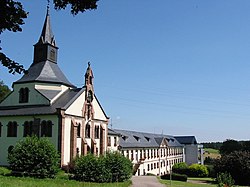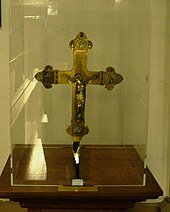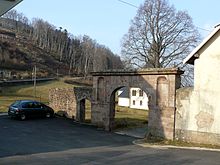Pairis Monastery
| Pairis Cistercian Abbey | |
|---|---|
 former Pairis monastery |
|
| location |
region Grand Est Haut-Rhin department |
| Coordinates: | 48 ° 7 '2.1 " N , 7 ° 7' 39.2" E |
| Serial number according to Janauschek |
138 |
| Patronage | St. Mary |
| founding year | 1138 |
| Year of dissolution / annulment |
1453 priory, 1792 |
| Mother monastery | Lützel Monastery (Lucelle) |
| Primary Abbey | Morimond Monastery |
|
Daughter monasteries |
no |
The pairis abbey or Päris (fr. Abbaye de Pairis ), actually Ave Maris Stella , was a Founded in 1138 Cistercian abbey in Greg Oriental in Orbey near Kaysersberg in Alsace (Region Grand Est ). It was closed in 1791 during the French Revolution .
history
The monastery was founded in 1138 by Ulrich, the grandson of Gerhard von Lothringen and the last Count of Egisheim . Twelve monks from the Lützel Monastery settled in Pairis at that time.
At the beginning of the 13th century, Pope Innocent III commissioned the abbot Martin to preach the fourth crusade in Alsace. His call was heard and Abbot Martin personally, accompanied by several monks, took part in the crusade , during which on April 13, 1204, Constantinople was conquered and sacked . Gunther von Pairis († around 1220), poet, historian and theologian, recorded the events in his Historia Constantinopolitana . He described the treasures and relics found in the city , some of which Abbot Martin took and transported to Pairis. The latter captured a trace of the blood of Christ, a piece of the True Cross , a significant part of the bones of St. John, an arm of St. James, a foot of St. Cosmas, a tooth of St. Lawrence and relics of another 28 males and 8 female saints.
These relics, brought from Constantinople by Abbot Martin, increased the importance and reputation of the abbey. Although King Albrecht I took Pairis under his special protection in 1300, decadence and the beginning of decay were reported in the course of the 14th century. In the Hundred Years War (1337-1453) the abbey was sacked by the English in 1356. Pairis was destroyed during the Armagnak invasion in 1444. It lost its title as an abbey and became a simple priory in 1453, which was subordinate to the Maulbronn monastery in Kraichgau. The close relationship with Maulbronn Monastery was to last until the Peace of Westphalia (1648).
The medieval complex was affected by the Palatinate Peasants' War in 1525 . Abbot Andreas of Austria had Pairis rebuilt towards the end of the 16th century. As a result of the Reformation (1537–48, 1557–1630 and from 1649), the Maulbronn convent moved entirely to Pairis.
During the Thirty Years' War (1618–1648) Gustaf Horn gave Pairis as a fief to the Wetzel von Marsilien family and they drove away the clergy. Louis XIII (1601–1643) gave the monastery back to the Cistercian order. From 1646 the reconstruction took place. Pairis experienced its last heyday in the 18th century. The monastery was closed in 1791 as a result of the French Revolution.
meaning
Pairis gained special importance through the works of Gunther von Pairis. His Annales Pairisienses describe the 4th Crusade and the conquest of Constantinople ( Historia Constantinopolitana ), and he also wrote an epic poem about Friedrich Barbarossa's Lombard war ( Ligurinus Güntheri ).
Abbot Philipp von Rathsamhausen , Bishop of Eichstätt (1306-1322), stood out as a theologian .
Pairis is a neighbor of the monastery Marienau present at Breisach repeatedly in documents, these two monasteries exchanged land and ground rents , which were in the catchment area of the other abbey. The points of contact were the ban of Mengen in Breisgau , but also Breisach itself, where Pairis apparently owned a town house. Especially in the Adelhauser Urbar , the Monks of Pairis are repeatedly mentioned as property neighbors.
The scriptorium of this Cistercian abbey was no less important . The necrology of the monastery shows that there was a school of calligraphy in Pairis as early as the 13th century . This is supported by some existing handwritten parchment codices . One of these manuscripts (No. 102), which contains a commentary on the Song of Songs ( cantus canticorum ) and on the Book of the Hierarchies of Angels ( liber de angelica hierarchia ) by Pseudo-Dionysius Areopagita , was published towards the end of the 13th or at the beginning written in the 14th century. Other manuscripts from Pairis are a copy of the Martyrologium Usuardi (14th century), a Gospel book (12th century) and a Missale ordinis sancti Benedicti (13th century).
In the city library of Colmar there are three outstanding books from the scriptorium by Pairis, a psalter from the 12th century (Ms 352) with neumes for musical notation, an antiphonal from the early 13th century with a signature by the illuminator Rucinus and a gradual (Ms 406), which was made around 1230. The colors gold and ultramarine blue dominate the paintings on the parchment Ms 406.
Buildings and plant

Only a portal from 1754, a hospital building from the 18th century and remnants of the monastery wall remain from the former complex. Today there is a nursing home in the convent building. At the main entrance, a lead glass work shows the coat of arms worn by Pairis in the times of the Kommendatarabbey . The entrance portal, the chapel and the residential building of the monastery have been listed since 1927 and are entered in the additional directory of the Monuments historiques .
In today's nursing home there is a grave slab from 1305. It comes either from the former abbey church or from the cloister. Three paintings from the 18th century hang in the building. One of the paintings depicts an unknown Cistercian monk, the others show the monastery. A plaque shows the coat of arms of Abbot Olivier de Foulongue and the year 1671. This abbot had parts of the monastery rebuilt. Construction was finished in 1741, and in 1753 a fire raged and destroyed the abbey church . The building that now houses the nursing home was built after the fire of 1753 and probably served as a residential building for the monks. After 1765 the abbey church was rebuilt. Your main altar is today in the church of Ungersheim . In 1791 the monastery was closed and the furniture was sold. A manufacturer bought the building, which first served as a textile factory, then faience was produced there and as early as 1804 the buildings were only used as a farm. The church was destroyed at the beginning of the 19th century. In 1839 only the crumbling church tower existed. In 1849 the Orbey Hospital bought the building and converted it into a rural hospital. Some buildings were added in the 20th century. Fires damaged the building in 1910 and 1924. In 1999, a 20th century farm was destroyed to add a wing to the hospital.
chapel
Parts of the church were used to build a chapel on the other side of the entrance portal in the 19th century. The chapel was dedicated to the Immaculate Conception . Today this chapel serves as a residential building.
In the house there is, among other things, a reliquary from the end of the 15th or beginning of the 16th century, which has been a listed monument since 2001 . Some of the bone fragments wrapped in cloths were added in the 17th and 18th centuries. This suggests that the reliquary was venerated until the revolution. The holy water font in the former chapel was constructed in the 19th century from a capital from the 12th century. It was entered in 1997 in the supplementary directory of the Monuments historiques . Another listed work of art is a group of sculptures from the 15th or 17th century. It shows a pietà .
literature
- Bernhard Buchinger, Abbot of Lützel: Tabula mortuorum Parisiensium 1650. Colmar City Library. In: Julius Rathgeber (Ed.): The rule of Rappoltstein. Contributions to the history of Upper Alsace, partly from documentary sources. F. Wolff, Strasbourg 1874, p. 58 ff.
- Joseph MB Clauss (ed.): The necrology of the Cistercian Abbey Pairis. In: Communications from the Society for the Conservation of Historical Monuments in Alsace. 2nd episode, 22nd volume, 1904, ZDB -ID 215236-8 , pp. 55-103.
- Carl Weinmann: Hymnarium Parisiense. The hymn of the Cistercian Abbey of Pairis in Alsace. From two codices of the 12th and 12th 13th century. Edited and annotated. Pustet, Regensburg 1904, p. 10 (Freiburg (Switzerland), university, phil. Dissertation, 1904). on-line
- Andreas Bauch: The theological-ascetic literature of the Eichstätter Bishop Philipp von Rathsamhausen (1306-1322) (= Eichstätter Studies. Vol. 6, ISSN 0170-9402 ). Publishing house of the Catholic Church in Bavaria, Eichstätt 1948.
- Fondation Mécénat (ed.): The Legacy of the Centuries. 2000 years of Alsatian writings. Fondation Mécénat, Science et Art, Strasbourg 1989.
- Gertrud Löbell, Isabelle Bridegroom: Alsace. Excursion experiences for the family throughout the year (= discovered - experienced - in love ). Schauenburg, Lahr 1996, ISBN 3-7946-0444-X , pp. 79-80.
- Stefan Schmidt: The Marienau choir stalls and the history of the abbey. 2nd Edition. Self-published by the author, Wyhl am Kaiserstuhl 2004.
Web links
Individual evidence
- ↑ a b c Angel Ingold: Ephémérides alsaciennes . 2nd Edition. Impr. D'E. Koenig, Mulhouse 1880, p. 37 f . (French, online ).
- ↑ Cf. Gérarld: Les artistes de l'Alsace , Paris 1872, vol I, p. 184; 339-341. on-line
- ↑ Cf. Kröner in the Strassburger Diözesanblatt, 20th year.
- ↑ a b Entry No. 68249 in the Base Mérimée of the French Ministry of Culture (French)
- ↑ Entry No. 68249 in the Base Palissy of the French Ministry of Culture (French)


